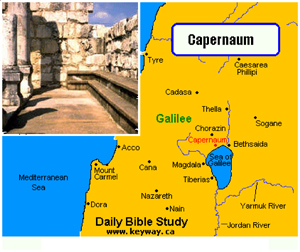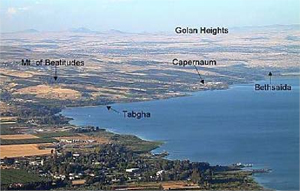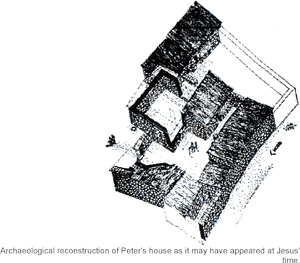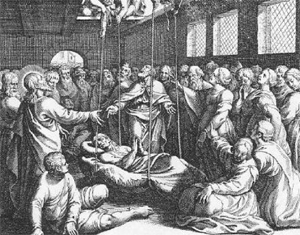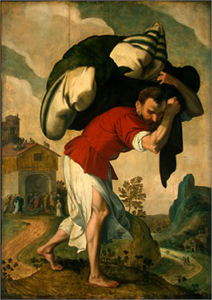
Christmas
Easter
Pentcoest
All Saints
Christ The King
Confirmation
Palm/Passion
Reformation
Stewardship
Books of the Bible
Lenten Series
Christmas Dramas
Videos
Series A - Matthew
Series B - Mark
Series C - Luke
Series D - Other
To contact
Edward F. Markquart
info@sfs.com
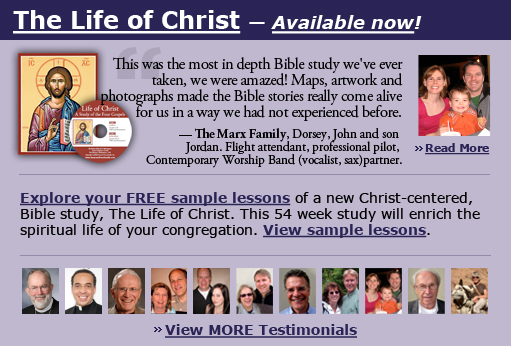
Series B EPIPHANY 7B Mark 2:1-12 Pastor Edward F. Markquart The following Bible study is from a larger course entitled, THE LIFE OF CHRIST: A Study in the Four Gospels. This 54 week course for the laity will be available for congregations in 2006. Basic text for the course: SYNOPSIS OF THE FOUR GOSPELS, Kurt Aland, English Edition, P. 40-41. THOUGHTS ABOUT THE HEALING MIRACLES OF JESUS The Gospel of Mark records ten consecutive incidents at the beginning of his gospel where Jesus healed people of their diseases. These healings were signs that the reign of God was present. Every normal person wants to be well, physically and emotionally. That was true in Jesus’ day; and that is true also today. Mental and physical health has always been important to human beings. Health and healings are signs of the Presence of God and the kingdom of God. When people, societies, and nations are healthy, that is good. Their health is a sign that the Presence of God is with them. But the issue is more complex than that. We also find that God is present during times of illness, suffering, and disease and in the deep valleys and deep shadows of death and dying. In fact, when we are suffering the most, God is with us. Even so, a sign of the kingdom of God is when evil and the demonic is eradicated. Every century and generation formulates its own understanding of diseases, their causes and their cures. Every generation an area of the world has its own particular diseases that are of primary concern. In the Biblical days of the New Testament, it was blindness, leprosy and lameness. Today, our society is concerned about cancer, heart attacks, and alcohol/drug addictions. The new modern plague and pandemic in the world is AIDs. The people of the New Testament generation did not have concepts of viruses, germs, heredity, and environment factors that contribute to the cause of diseases. The New Testament generation simply believed that “sin,” “demons” and “evil spirits” caused diseases. The Old and New Testaments were written in a pre-scientific age. Diseases and illnesses have been regarded as undesirable and evil, regardless of century of those diseases. People of every generation work at getting rid of those illnesses. A high percentage of diseases have always been caused by sinful behaviors and attitudes, by dispositions of the mind and actions of the body. Studies today conclude that 85% of all illnesses that physicians see today are caused by psychological attitudes. One study about cancer prone mice put those mice into a laboratory test. One group of cancer prone mice had enormous stress put on them; the second group was stress free. 92% of the first group of stressed mice developed cancer; 7% of the second group of stress-free mice developed cancer. Stress in mice affected their immune systems at a 92% rate. In other words, people today are well aware that stress and psychological “dis-eases” contribute to physiological diseases. Also, if companies pollute a river with waste that contains carcinogens, people living near that river will have a higher incidence of cancer. Likewise, people will have a higher rate of cancer if they live with asbestos in their homes, live near an aging smokestack, or live near a company that has been polluting the environment. The higher rate of cancer in those situations will be a symptom of sinful decisions and behaviors permeating the environment in which people live. Many people, then and now, often ask the question when they or their loved ones are sick: “Why is God punishing us?” Illness is often seen as a punishment from God. In the Bible, we remember the question: “Is this man blind because his parents sinned or because he sinned?” Many people intuitively and erroneously believe that illness is simply a consequence of sin, an evidence of sinful consequences. The Book of Job was written to counter this simplistic conclusion. That is, there are illnesses which are a result of sinful and foolish behaviors; there are illnesses which are notthe result of sinful and foolish behaviors. It is not simply true that all illness is God’s punishment for sinful behavior. The healing miracles of Jesus have inspired the church in every century to be engaged in the art and science of healing as evidence of the reign of God. Doctors and nurses today are still drawn to the medical professions as a way of helping people. Hospitals are often named after religious figures. According to the Gospels, Jesus was involved in sixteen healing miracles, whereby God, through Jesus and the power of faith, healed people.
#43 THE HEALING OF THE PARALYTIC Matthew 9:1-8, Mark 2:1-12, Luke 5:17 26 This is another great miracle story, colorful in its details, and is told in all three gospels. The story is graphic and can easily been seen in one’s imagination. -When he returned to Capernaum after some days, it was reported that he was at home. In our imaginations and archeological memories, we can visualize the city, his house, and the location of this miracle. Focus on the words, “at home.” This appears to be Jesus’ home in Capernaum. See Luke words, “came to his own city.” Remember Matthew 4:13, “Leaving Nazareth, he went and lived in Capernaum.” We remember the archeological ruins of Peter’s house in Capernaum. Capernaum was Jesus’ own city and perhaps Jesus had a home in Capernaum. http://www.execulink.com/~wblank/20020117.htm
http://www.christiananswers.net/bibleplaces/home.html The geography of Jesus: The picture below is a fantastic photograph and needs to be memorized in your mind in order to remember many of the most important geographic locations in Jesus’ life. This photograph will be repeated often in this course. Find and focus on the location of Tabgha, the location of the feeding of the 5000.
http://www.gnmagazine.org/issues/gn25/archaeologyministry.htm “Their soil," wrote the Jewish historian Josephus, "is universally rich and fruitful, and full of the plantations of trees of all sorts, insomuch that it invites, by its fruitfulness, the most slothful to take pains in its cultivation. Accordingly it is all cultivated by its inhabitants, and no part lies idle" (Wars of the Jews, Book III, Chapter III, Section 2). Jesus drew many of His parables and illustrations from daily life and activities around the lake. The site of Capernaum, which means "village of Nahum," was identified in 1838 and was extensively excavated during this century. What have archaeologists found? John Laughlin, professor of religion at Averett College,Danville, VA., participated in excavations at Capernaum. He comments: "What is known indicates that at this time Capernaum was a small village located on the shore of the Sea of Galilee with a population of probably no more than 1,000 people. The few architectural remains indicate the buildings were spacious and well constructed of dressed stones and large amounts of plaster. This suggests that the village flourished economically during Jesus' time. Its location on the crossroads of important trade routes, the fertile lands surrounding it and the rich fishing available all contributed to its economic development" (Biblical Archaeological Review, September-October 1993, p. 59). "The first century house (Peter’s house) was built around two courtyards with the outside entrance opening directly into one of the courtyards. A taboun (round oven) was found in this courtyard, which indicates it was used as the main family room. The southern courtyard may have been used for animals or as a working area. In either size or building material, the house is not unlike all the other houses found in Capernaum" (McRay, pp. 164-165).” The following is a diagram of the reconstruction of Peter’s house. Peter’s house was most likely similar to Jesus’ house in the same city. http://www.christiananswers.net/dictionary/capernaum.html
-The power of the Lord was with him to heal. (only Luke) Luke likes the word, “power.” Acts 1:8, “When the Holy Spirit comes upon you, you will receive power.” Several times Luke uses the word, “power,” and associates that power with the Spirit and healing. We will also see this healing “power” in one of Luke’s next stories. Luke refers to this “power” seventeen times in the Gospel of Luke and eleven times in Acts. -So many gathered around that there was no longer room for them, not even in front of the door; and he was speaking the word to them. We can easily visualize a crowded room. Luke tells us that people had come from every village of Galilee and Judea and even from Jerusalem. -Then some people came, bringing to him a paralyzed man, carried by four of them. Friends are important to our faith. It was not only the paralyzed man who believed but his four friends also believed. The four friends had faith. Jesus saw their faith. Often our friends encourage and enlarge the faith that we have. (That is what the story of Daniel is about, the four friends who helped each other be loyal to their faith and religious practices.) -And when they could not bring him to Jesus because of the crowd, they removed the roof above him; -and after having dug through it, they let down the mat on which the paralytic lay. http://home.halden.net/rolf/merian/m154.jpg Matthaeus Merian the Elder, 1625-30.
What do you see in the picture? The sick man. Jesus. People crowded in a hall. The crowds looking up. Friends up above who lowered the sick man down. Windows with iron grates. A hall that looks like it is from seventeenth century Europe. -When Jesus saw their faith, Circle the word, “faith.” This is one of the many stories where Jesus emphasized the power of faith. In a secular way, we know the power of faith in modern medicine. That is, studies have been conducted on patients with arthritis. One group of patients was given a placebo of sugar water but through a painful looking syringe. A second group was given genuine medicine by mouth via pill. The results? The placebo of sugar water was more effective at relieving arthritic pain than the actual medicine. Why? Because the group who received the treatment by the syringe believed that they were being helped and healed. The power of their believing was actually stronger than the authentic medicine itself. In today’s word, we understand the power of faith, the power of believing and trust. We remember that the word “faith” and its parallels (e.g. “believe”) are used 425 times in the Bible, especially in the New Testament. -He said to the paralytic, "Son, your sins are forgiven." This line is the key to the story. Jesus has the power to forgive sins, and when sins are forgiven, there is healing in one’s life. This was true centuries ago and is often true today. That is, a particular sin or sins can work deeply in the psyche so much as to create physical paralysis. I personally have seen people literally paralyzed by guilt and sin. Perhaps you have seen such a person as well. Perhaps you are that person. What is needed more than anything else in this situation is forgiveness. -Now some of the scribes were sitting there, questioning in their hearts, "Why does this fellow speak in this way? In the first three gospels, the “enemy” of Christ was almost always the scribes and the Pharisees, who were the leaders of the Jewish establishment. The scribes were the ones who had their advanced degrees in knowledge of the Biblical laws of the Torah, the first five books of the Old Testament. They and the Pharisees were partners in thought and attitude: they were the strict interpreters of the Old Testament Law for their daily lives. They thought that other people should live according to their strict interpretations of the Old Testament Torah. -It is blasphemy! Who can forgive sins but God alone?" Circle the word, “blasphemy.” Blasphemy is the ultimate charge that was leveled at Jesus. Blasphemy was making one’s self equivalent to God. Human beings are not to elevate themselves to divinity. In Leviticus 24:16 of the Jewish Torah, blasphemy was to be punished by stoning. The Pharisees tried to trap Jesus again and again. In response, again and again, Jesus asked the Pharisees a razor sharp question that they could not answer. Jesus was forever trapping the Pharisees with his penetrating questions and analysis. -At once Jesus perceived in his spirit that they were discussing these questions among themselves; and he said to them, "Why do you raise such questions in your hearts? Which is easier, to say to the paralytic, "Your sins are forgiven,' or to say, "Stand up and take your mat and walk'? Jesus put the scribes and Pharisees on the defensive. Jesus, as always, put "the squeeze" on the doubters and trapped them in their own confessions.
-But so that you may know that the Son of Man has authority on earth to forgive sins" In this passage, Jesus identified himself as the Son of Man who not only comes at the end of history to be the final judge, but also has the power to forgive sins. In the Old Testament, only God had the authority to forgive sins. Now, Jesus was assuming that authority of forgiveness, making himself equal with God. We will slowly discover that the primary title that Jesus applied to himself was "Son of man." As students of the Bible, we recall that there was a primary reference to the Son of man in the Book of Daniel that clearly applied to the life of Jesus. Daniel 7:13-14: "In my vision at night I looked, and there before me was one like a son of man, coming with the clouds of heaven. He approached the Ancient of Days (God) and was led into his presence. He was given authority, glory and sovereign power; all peoples, nations and men of every language worshiped him. His dominion is an everlasting dominion that will not pass away, and his kingdom is one that will never be destroyed.” As a person reads these verses from Daniel, they describe what Jesus was and came to be. Jesus was given authority, power and glory and all people came to worship him. Jesus’ kingdom was an everlasting kingdom that could never be destroyed. At the end of time, Jesus was going to come on the clouds of heaven so that all people could see his arrival on this earth. The Book of Daniel’s description of the Son of man was fulfilled in the person of Jesus. We are going to watch for the many times in the gospels that Jesus will refer to himself as the Son of man. Jesus will consistently do this, referring to the Son of man in the third person, but clearly referring to himself. Mark 2:10 and its parallels illustrate this pattern. -He said to the paralytic— "I say to you, stand up, take your mat and go to your home." What great news. What healing. We are also keenly aware that Jesus spoke this particular word to this particular man. It isn't that Jesus says to all sick people to get out of bed and be healed. Real life does not work that way. -And he stood up, and immediately took the mat and went out before all of them; so that they were all amazed and glorified God, saying, "We have never seen anything like this!" That is the way the people reacted to the healing miracle that happened to them and is also the way we also respond when we experience God’s miraculous healing in our lives. Of course, it is not inevitable that a healed person will praise God and share the good news of God’s healing. We will study the story of the ten lepers who were healed and only one came back to thank Jesus for the healing that was given to all ten of them. But there is power to the testimony of God’s healing in one’s own life. http://www.nga.gov/cgi-bin/pimage?12210+0+0
Netherlands, 16th Century What do you see in this painting? A man carrying his bedding. His strong legs and arms. A tall building in the background with people on the roof, implying that they were the ones who cut the hole in the room. The building feels European, sixteenth century. Most of all, we see a man who had been healed by Jesus. When we see a person that we know was healed by the power and presence of God, we rejoice immensely. |
